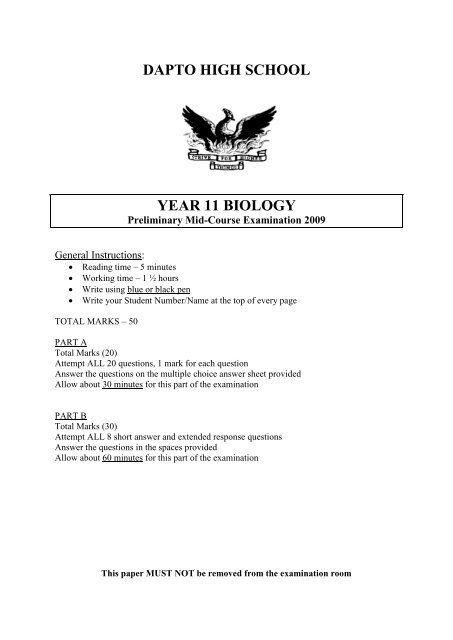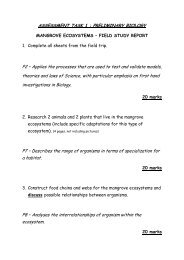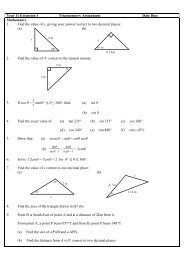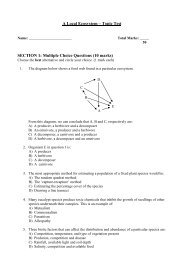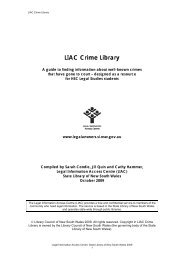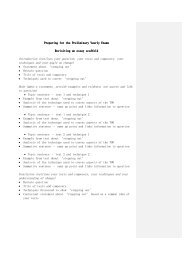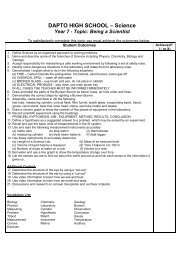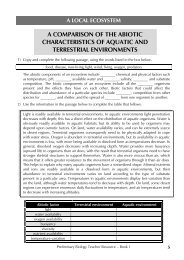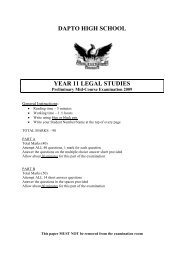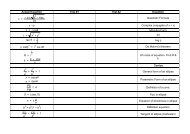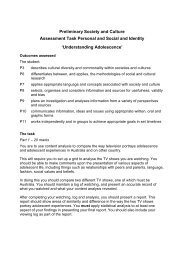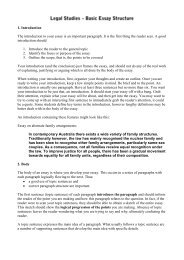DAPTO HIGH SCHOOL YEAR 11 BIOLOGY
DAPTO HIGH SCHOOL YEAR 11 BIOLOGY
DAPTO HIGH SCHOOL YEAR 11 BIOLOGY
- No tags were found...
You also want an ePaper? Increase the reach of your titles
YUMPU automatically turns print PDFs into web optimized ePapers that Google loves.
<strong>DAPTO</strong> <strong>HIGH</strong> <strong>SCHOOL</strong><strong>YEAR</strong> <strong>11</strong> <strong>BIOLOGY</strong>Preliminary Mid-Course Examination 2009General Instructions:Reading time – 5 minutesWorking time – 1 ½ hoursWrite using blue or black penWrite your Student Number/Name at the top of every pageTOTAL MARKS – 50PART ATotal Marks (20)Attempt ALL 20 questions, 1 mark for each questionAnswer the questions on the multiple choice answer sheet providedAllow about 30 minutes for this part of the examinationPART BTotal Marks (30)Attempt ALL 8 short answer and extended response questionsAnswer the questions in the spaces providedAllow about 60 minutes for this part of the examinationThis paper MUST NOT be removed from the examination room
PART A20 marksAttempt ALL questionsMark your answers on the answer sheet providedSelect the alternative A, B, C, D that best answers the questionSTUDENT NUMBER/NAME: ……………………..1. Why was Robert Hooke the first person to describe cells?(A) he invented the compound microscope(B) he invented the first reflecting telescope(C) he discovered cork(D) he invented staining techniques2. Poisons, such as DDT and dieldrin, accumulate in the body tissues.Which of the following organisms is most likely to concentrate the highest levels ofpoisons in their body tissues?(A) producers(B) herbivores(C) carnivores(D) decomposers3. The following diagram shows Chaesipho columna, the honeycomb barnacle.This organism is a small greyish barnacle, which has four plates. It often occurs insuch numbers that the plates become hard to identify for any one individual. Whatwould be the best way to determine the abundance of this barnacle?(A) percentage cover(B) capture-mark-recapture(C) tagging individuals and following their movement(D) count all individuals4. Robert Brown made the following observation:‘In each cell of the epidermis of a great part of this family ... a single circularareola, generally more opaque than, the membrane of the cell, is observable. Thisareola, which is more or less distinctly granular, is slightly convex ...’What was he describing?(A) mitochondria(B) chloroplast(C) nucleus(D) lysosome5. Which organelles are mainly involved with the transformation of energy?(A) chloroplasts, mitochondria(B) lysosomes, nuclei(C) nuclei, mitochondria(D) lysosomes, chloroplastsPage 2
STUDENT NUMBER/NAME: ……………………..6. While investigating the difference between plant and animal cells, students needed tomake wet mount slides of different tissues.Which of the following methods is the preferable method to use when placing a coverslip on a prepared specimen on a microscope slide?7. The diagram shows part of an organic molecule.Identify the group this molecule belongs to.(A)(B)(C)(D)carbohydrateproteinslipidsnucleic acids8. Which of the following would cause the most damage to the ecosystem?(A) introducing a foreign plant species into a suburban garden(B) introducing a foreign plant species with no known predator into the bus(C) using river water for human consumption(D) building a house on an open area of grassland9. The electron micrograph shows an organelle.Which chemical reaction is the main function of this organelle?(A) respiration(B) photosynthesis(C) transpiration(D) translocationPage 3
STUDENT NUMBER/NAME: ……………………..10. A thin section of an unknown tissue was stained with several different dyes todetermine if the tissue came from a plant or animal. Which of the following is leastlikely to show that the tissue came from a plant?(A) iodine showed starch granules(B) toluidine blue showed lignified cell walls(C) phloroglucin stained lignin in xylem cells(D) sudan IV stained lipid droplets<strong>11</strong>. The following food chain shows the relationship between four organisms.Grass Grasshopper Wolf Spider MagpieIf the grass has 100 units of energy, how much of this energy reaches the magpie?(A) 50%(B) 10%(C) 1%(D) 0.1%12. The diagram shows an animal cell with several organelles.Which chemical test would identify the substances produced by structure Q?(A) biuret solution(B) Benedict’s solution(C) iodine solution(D) Sudan IV13. Which of the following correctly identifies the instrument and the abiotic variable inan ecosystem it is used to measure?(A)(B)(C)(D)Abiotic VariableWind speedAcidityHumiditySpecific gravityInstrumentBarometerUniversal IndictorAnemometerThermometer14. Which of the following would be two of the most important abiotic factorsdetermining the abundance and distribution of Australian organisms?(A) predators and food source(B) temperature and rainfall(C) water availability and introduced species(D) humidity and soil fertilityPage 4
STUDENT NUMBER/NAME: ……………………..15. The graph shows the change in population size for three (3) freshwater pond species.Animal Y was in abundance when Animals X and Z were introduced.Animal X preys on Animal YAnimal Z preys on Animal XWhich of the following correctly indentifies each animal?(A)(B)(C)(D)Line I Line II Line IIIAnimal X Animal Y Animal ZAnimal Y Animal X Animal ZAnimal Y Animal Z Animal XAnimal Z Animal Y Animal X16. The following diagrams shows the profile of a medium-sized rock pool.Which of the following correctly describes the temperature of this rock pool?(A) the same temperature as the ocean(B) higher than ocean temperature(C) lower than ocean temperature(D) higher during the day and lower at night than ocean temperaturePage 5
17. The diagram shows part of a food web in an ecosystemSTUDENT NUMBER/NAME: ……………………..What can you deduce from this food web?(A) organism X provided chemical energy to all other organisms(B) organisms X, Y, W and Z must all be producers(C) the biomass of organisms Z is greater than the biomass of any other organism(D) organisms Y and W are parasites and organism Z is a decomposer18. The map shows the distribution of rainforests in eastern Australia.What can be concluded from this map?(A) all large rainforests are above 20° latitude(B) rainforests are only found in tropical areas(C) rainforests prefer conditions between latitudes 20° and 30°(D) factors other than latitude help determine the size of rainforestsPage 6
STUDENT NUMBER/NAME: ……………………..19. The diagram shows an organism found in freshwater ponds.Consider the structure of its legs and general body shape to determine its locomotionin the pond and where you would most likely find this animal.(A) swimming in the bottom layers of a quiet lake(B) burrowing into mud and ooze at the bottom of a quiet lake(C) walking on the surface of the water(D) clinging to rocks in a fast-flowing stream20. Which of the following energy pyramids shows a balanced, self-sustainingecosystem?END OF PART APage 7
PART B30 marksAttempt ALL questionsAnswer the questions in the spaces providedSTUDENT NUMBER/NAME: ……………………..Question 21 (2 marks)Study the diagram of the organelle belowMarksa) Identify the organelle labelled A. ___________________________________ 1b) State its function ________________________________________________ 1______________________________________________________________Question 22 (2 marks)Write a word equation for photosynthesis. 2_____________________________________________________________________Question 23 (2 marks)Write a word equation for aerobic cellular respiration. 2_____________________________________________________________________Question 24 (3 marks)a) Define adaptation. ________________________________________________ 1_______________________________________________________________b) Identify one adaptation of a living organism to its particular environment. 2____________________________________________________________________________________________________________________________________________________________________________________________________________________________________________________________Page 8
STUDENT NUMBER/NAME: ……………………..MarksQuestion 25 (3 marks)Construct a table to show the difference in TWO (2) named abiotic features betweenaquatic and terrestrial environments. 3Question 26 (3 marks)Dyticid beetles are large black carnivorous beetles found at all levels in a freshwaterpond.These beetles can be seen swimming to the surface ‘capturing’ a bubble of airbetween their wing tips and the end of their abdomen and then diving downagain. Explain this behaviour. 3_____________________________________________________________________________________________________________________________________________________________________________________________________________________________________________________________________________________________________________________________________________________________________________________________________________________________________________________________________________________________________________________________________________________________________________________________________________________________________________Page 9
STUDENT NUMBER/NAME: ……………………..MarksQuestion 27 (9 marks)Some senior biology students wished to estimate the abundance of each species on anarea of rock platform. They decided to place four quadrats within the area, the followingdiagram shows an area of a rock platform with three (3) species and the location of thefour (4) quadrats.a) Construct a table to show the number of species in each four (4) labelledquadrats. 2b) Calculate the average density of Austrocochlea per quadrat. _______________ 1______________________________________________________________________________________________________________________________c) If each quadrate is 1m x 1m in dimension and the total area is 19.2m 2 , how manyAustrocochlea would you ESTIMATE to be in the whole area? 1______________________________________________________________________________________________________________________________d) How many Austrocochlea are actually in the whole area? 1_______________________________________________________________e) Calculate the percentage error in this quadrate method of calculating thenumber of organism in an area, using the formula:% deviation =difference between estimated and actual totalactual total× 100% 1_______________________________________________________________Page 10
STUDENT NUMBER/NAME: ……………………..Question 27 (continued)f) Comment on the validity and accuracy of these results. _____________________________________________________________________________________________________________________________________________________________________________________________________________________________________________________________________________________________________________________________________________Marksg) Suggest one (1) way to improve the accuracy of this method. ______________ 1______________________________________________________________________________________________________________________________Question 28 (6 marks)Evaluate the method you used to estimate the abundance of a named species on yourfield trip. 6__________________________________________________________________________________________________________________________________________________________________________________________________________________________________________________________________________________________________________________________________________________________________________________________________________________________________________________________________________________________________________________________________________________________________________________________________________________________________________________________________________________________________________________________________________________________________________________________________________________________________________________________________________________________________________________________________________________________________________________________________________________________________________________________________________________________________________________________________________________________________________________________________________________________________________________________________________________________END OF PART BEND OF EXAMINATIONPage <strong>11</strong>
STUDENT NUMBER/NAME: ……………………..<strong>DAPTO</strong> <strong>HIGH</strong> <strong>SCHOOL</strong><strong>YEAR</strong> <strong>11</strong> <strong>BIOLOGY</strong>Preliminary Mid-Course Examination 2009Name: ......................................... Result: 20+ 30= 50%PART AMULTIPLE CHOICE ANSWER SHEETChoose the BEST answer and place an X in the space on the grid provided.12345678910<strong>11</strong>121314151617181920A B C DThis paper MUST NOT be removed from the examination roomPage 12


